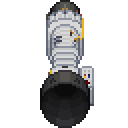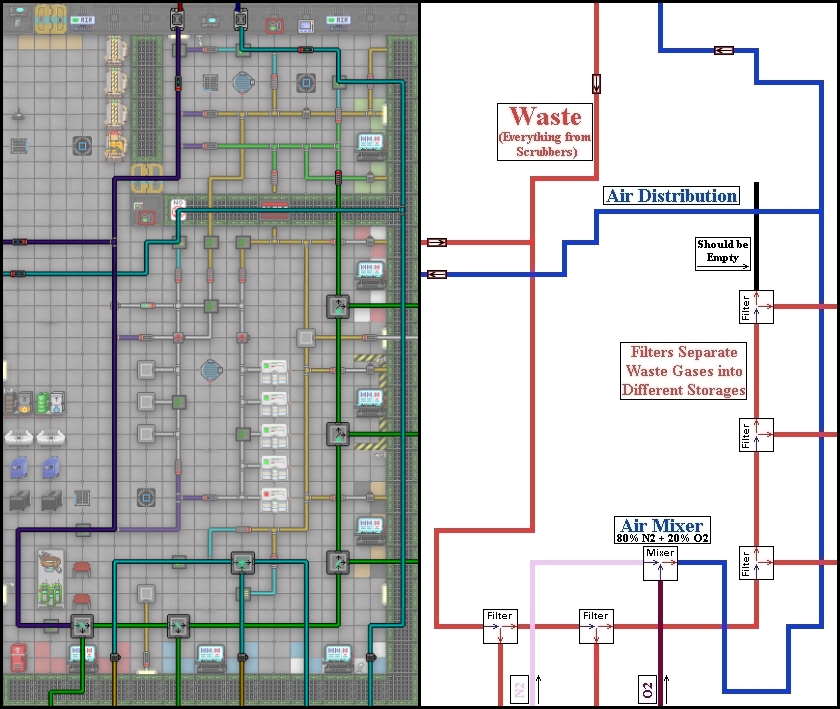Difference between revisions of "Guide to Atmospherics"
Sirryan2002 (talk | contribs) m (clean up) |
|||
| Line 225: | Line 225: | ||
|The dark blue pipe is the '''Main Air Supply'''. It sends breathable air (roughly 80% nitrogen and 20% oxygen) to all the vents on the station, and is fed by the cyan pipe in Atmospherics. | |The dark blue pipe is the '''Main Air Supply'''. It sends breathable air (roughly 80% nitrogen and 20% oxygen) to all the vents on the station, and is fed by the cyan pipe in Atmospherics. | ||
|- | |- | ||
!Scrubber <br> [[File:Scrubber_pipe.png| | !Scrubber <br> [[File:Scrubber_pipe.png|32px]] | ||
|The red pipe is the '''Scrubber Pipe'''. This is where all the toxic waste normally ends up by the scrubber system found all around the station. It may contain breathable air, however it is unfiltered and possibly contaminated. | |The red pipe is the '''Scrubber Pipe'''. This is where all the toxic waste normally ends up by the scrubber system found all around the station. It may contain breathable air, however it is unfiltered and possibly contaminated. | ||
|- | |- | ||
| Line 240: | Line 240: | ||
|The yellow pipe is the '''Mix Pipe''', which is internal to Atmospherics and is used for custom air mixes. | |The yellow pipe is the '''Mix Pipe''', which is internal to Atmospherics and is used for custom air mixes. | ||
|} | |} | ||
=The Basic Mathmatical Details= | =The Basic Mathmatical Details= | ||
Revision as of 10:08, 1 April 2021
Atmospherics. To the ignorant, a mystical art indecipherable from actual magic. To the (hopefully) educated Atmospheric Technicians of the station, a glorified network of conveyors for moving gases about. Either way, Atmospherics holds great and terrifying power in the hands of the initiated.
Pipes and Gases, the Basics of Atmos
If you aren't working with pipes and gases, you aren't doing atmospherics.
Where to get Pipes
Meet your two new friends. One never returns the money they borrow, you aren't really sure why you hang out with them. The other one is kind of awesome.
 Pipe Dispenser - A static machine that will print out pipes for you.
Pipe Dispenser - A static machine that will print out pipes for you.
 Rapid Pipe Dispenser - A hand held tool that can print, place and recycle pipes for you. Fits in your backpack and doesn't need ammo.
Rapid Pipe Dispenser - A hand held tool that can print, place and recycle pipes for you. Fits in your backpack and doesn't need ammo.
Beneath are all the things your dispenser can make. Learn them well, for they are the fabric from which atmos is woven.
Types of Atmospheric Pipes
| Items | Name | Description | Details |
| Atmospheric Pipes | Generic Pipes that can be used for most tasks | These are airtight pipes that can carry any gas you pump into them. | |
| Air Supply Pipe | Used to distribute air all across the station. | Special pipes that are needed to connect to vents. Standard unaltered atmos uses these for air distribution | |
| Scrubber Pipe | used to move waste or harmful gases. | Special Pipes that are needed to connect to scrubbers. Standard unaltered atmos uses these for taking in and processing harmful gases like CO2. | |
| Heat Exchange Pipe | Imparts some of the enviroments temperature to it's contents. | Allow you to cool / heat gases based on the ambient temperature of the tile they're on. Think space loop (for cooling) or the Toxins burn chamber (for heating) | |
| Universal Pipe Adapter | Can be fitted to any other pipe type. | Used to bridge between Atmospheric, Scrubber and Supply pipes. Atmospheric, Scrubber and Supply pipes cannot connect to eachother without this. |
Types of Atmospheric Devices
Types of Disposal Pipe
The Gases
The main goal of atmospherics is to manipulate these in a way that benefits the station. Each type of Gas has different properties that can help or hinder. Your skill in manipulating these will determine the success of your atmospheric machinations.
| Nitrogen (N2) | One of the components of the air mix. N2 soaks up heat in the air, and lowers the temperature of a fire. By association, it can very quickly lower the temperature of a fiery rupture to the point where the flames self-extinguish. |
| Oxygen (O2) | You probably breathe this. Running out of O2 will cause your slow death by suffocation damage. It is also required for a fire to even start, with the ending the fire when the O2 or plasma (if present) is depleted. Having less than 17 kPa of O2 flowing into your lungs chokes you. |
| Air | The gas mix that is distributed in the station. It is composed of 80% N2 and 20% O2. |
| CO2 | An invisible, heavy gas, CO2 is one of the first and fastest gases the scrubbers suck out of the air. It chokes people effectively and quickly, and if you can be bothered to set the air alarms up, will result in a invisible room that kills those in it. Takes some setup and can be very, very annoying. The emote for this at below incapacitating levels is gasping and choking. |
| Nitrous Oxide (N2O) | A white-flecked gas. Makes you laugh at low doses and at higher ones puts you to sleep. Scrubbers don't deal with it too well and portable scrubbers just choke on it. If using this as a sleep gas mix do *not* forget the O2 at at least 17 kPa, or you will kill someone. Relativly high in density at room temperature. |
| Plasma | The oil of the new world. Purple, highly flamable, and highly toxic ("Toxins" and "Plasma" are occasionally used interchangably). Burns hotter as oxygen is added. Can spontainiously ignite if at high pressure with oxygen. The highest density gas at room temperature. |
Station Systems
While pipes themselves will always work if undamaged, atmospheric devices all have certain prerequisites that must be met for them to operate.
Remember, ALL Atmos Devices require a powered APC to work.
In addition, there are other pieces of infrastructure that can/must be used when working with specific atmospheric devices.
Air Alarm
Mandatory for the use of non-passive vents and scrubbers. Allows a wide range of control over a blueprinted rooms current gas contents. Where exactly the Air Alarm is in the room does not matter; As long as the room is blueprinted and powered it will function. Cannot be placed in areas that are not blueprinted.
To learn more about Air Alarms and how to use them, click here: Air Alarm
Computers Consoles
- Atmospheric Alert Computer: This computer console will tell you where your attention is needed. Green means everything is alright, yellow signals something is wrong, and red means things have gone wrong enough for an alarm to be triggered (Usually caused when a room's air stops being breathable).
- Central Atmospherics Computer: Allows remote control of any air alarm on the station that has remote access enabled.
- The Distribution Computers: A console to monitor gas storage contents, control air injectors/extraction vents, etc. If you understand how to use these properly, you probably know what you are doing. Air Injectors REQUIRE these to work.
Atmosia Proper - The beating heart of the Station
In Atmosia, you will see many different colored pipes. These colors are labels, marking out different systems within atmosia.
The Basic Mathmatical Details
Ideal Gas Law
The magical formula for improving your burn mixes.... and explaining why your coolant pipes have such a low pressure.
Formula: PV=nRT
P - Pressure in kilopascals or kPa
V - Volume in liters
n - is the amount of substance of gas (also known as number of moles)
R - is a constant or 8.31
T - Temperature in Kelvin
Cooling a gas will make it take up less space (volume) for each unit (mole) of said gas. This effect also results in a gas at a lower temperature having a lower pressure. Heating a gas will have the opposite effect, resulting in a larger volume and higher pressure per mole.
Conversion to and from Kelvin
While most things will yield temperature in both Kelvin and Celsius, here is the conversion formula just in case.
Formula: K = C + 273.15
C - Celsius
K - Kelvin
(Temperature in Kelvin minus 273.15 is that same temperature, but in Celsius)
Additional Guides
 Guide to Gas Turbine
Guide to Gas Turbine- File:TEG.png Guide to Thermoelectric Generator
 Guide to Supermatter Engine
Guide to Supermatter Engine Guide to Air Alarms
Guide to Air Alarms

